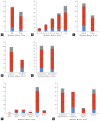Medical disputes involving lower gastrointestinal endoscopies: cases from the Korean Medical Dispute Mediation and Arbitration Agency
- PMID: 40360220
- PMCID: PMC12081107
- DOI: 10.3904/kjim.2024.343
Medical disputes involving lower gastrointestinal endoscopies: cases from the Korean Medical Dispute Mediation and Arbitration Agency
Abstract
Background/aims: As the number of lower gastrointestinal endoscopies and high-risk examinees increases, the incidence of adverse events associated with these endoscopies has also increased. Medical disputes and lawsuits related to adverse events are rapidly increasing.
Methods: Medical disputes related to lower gastrointestinal endoscopy that had been filed in Korean Medical Dispute Mediation and Arbitration Agency (K-medi) from April 2012 to August 2020 were evaluated with the corresponding medical records and written appraisal. Facilities, patients, procedures, adverse events, and outcome-related variables related to medical disputes were analyzed.
Results: As the number of lower gastrointestinal endoscopies in Korea increases each year, the number of medical disputes related to lower gastrointestinal endoscopy appraised by K-medi has also increased yearly during the same period. Among the 121 cases analyzed, 86 (71.1%) were conciliated and 35 (28.9%) were cosigned by prosecution. Perforations accounted for the largest proportion of cases (93 cases, 76.9%). Most patients (n = 119, 98.3%) underwent non-emergent procedures, and only 10 (8.3%) underwent them for therapeutic purposes. Approximately one-fifth of the patients (n = 25, 20.7%) died.
Conclusion: The number of medical disputes related to lower gastrointestinal endoscopy are increasing. To prevent this, it is important to review the data on existing cases and establish specific response guidelines.
Keywords: Colonoscopy; Medical accidents; Medical errors; Medical litigation; Patient safety.
Conflict of interest statement
The authors declare no conflicts.
Figures







Similar articles
-
Dispute cases related to pain management in Korea: analysis of Korea Medical Dispute Mediation and Arbitration Agency data.Anesth Pain Med (Seoul). 2020 Jan 31;15(1):96-102. doi: 10.17085/apm.2020.15.1.96. Anesth Pain Med (Seoul). 2020. PMID: 33329797 Free PMC article.
-
The Effects of Criminal Punishment on Medical Practices in the Medical Environment.Int J Environ Res Public Health. 2019 Feb 19;16(4):604. doi: 10.3390/ijerph16040604. Int J Environ Res Public Health. 2019. PMID: 30791428 Free PMC article.
-
The role of mediation in solving medical disputes in China.BMC Health Serv Res. 2020 Mar 18;20(1):225. doi: 10.1186/s12913-020-5044-7. BMC Health Serv Res. 2020. PMID: 32183806 Free PMC article.
-
Mediation as an opportunity in disputes relating to compensation for adverse medical events - international experiences.Pol Merkur Lekarski. 2020 Oct 23;48(287):375-378. Pol Merkur Lekarski. 2020. PMID: 33130803 Review.
-
Alternative dispute resolution: Mediation as a model.F1000Res. 2025 Jan 14;13:778. doi: 10.12688/f1000research.152362.2. eCollection 2024. F1000Res. 2025. PMID: 39926000 Free PMC article. Review.
References
MeSH terms
Grants and funding
LinkOut - more resources
Full Text Sources
Research Materials
Miscellaneous
